- Joined
- Oct 18, 2022
- Messages
- 333
Shortly after 1pm on a clear and sunny June 16th, 1966, a pair of commercial tankers attempted to pass each other in the confined waters off Bergen Point, where the Kill Van Kull and Newark Bay meet beneath the Bayonne Bridge. The outbound tanker, SS Texaco Massachusetts, was riding high and empty after completing a delivery to the Texaco Bayonne terminal earlier in the day and was under command of a Harbor Pilot with the tugboat Latin American made up to her Port bow for ship assist duties. Moving slowly towards Bergen Point to allow a group of inbound vessels to pass, the tanker increased speed to make its turn towards New York Harbor well ahead of another inbound vessel coming up the Kill - the fully loaded 546ft British-flagged tanker Alva Cape.
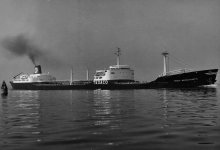
SS Texaco Massachusetts
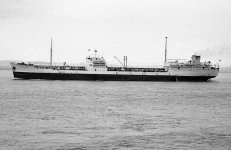
MV Alva Cape
Destined for the Bayway refinery and fully loaded with 132,854 barrels Light Virgin Naphtha, the Alva Cape was under the command of a Docking Pilot and being escorted by the tugboats Esso Massachusetts and Esso Vermont, the ship was nearing the Bayonne Bridge when her pilots hailed the outbound Texaco Massachusetts by radio to confirm their passing arrangements. Despite their discussion and agreement that the Texaco Massachusetts had the right of way in the upcoming routine passing situation, the two pilots improperly gauged the speed of each others vessels and in a matter of minutes the two ships were drawing dangerously close to each other. Recognizing the imminent danger, the pilot aboard the Texaco Massachusetts ordered the ships engines to full Astern in an attempt to bring the ship to a halt from its 3 knot speed while aboard the Alva Cape the pilot ordered the ships engine stopped and ordered the tug Esso Massachusetts to push her bow to Starboard in an effort to comb the approaching ship. These efforts were for naught. With a collision was imminent, Alva Cape’s engines were ordered to full Astern and her Starboard anchor dropped shortly before the bow of the high-riding Texaco Massachusetts cut into the Alva Cape on her Starboard hull near the front of her #1 cargo tank and penetrated a full 12ft into the ship before coming to a stop.
Despite immediately ordering the ships cargo smothering system energized to prevent an explosion from his ships highly flammable load, the Captain of the Alva Cape was unable to stop the engines of the Texaco Massachusetts, which were still running in full reverse, from pulling the vessel away from and removing the "plug" formed by the bow in the cargo tank. As the two ships separated with a tremendous jolt, a large amount of liquid Naphtha roiled forth from the Alva Cape and into the waters between the two ships and quickly began to gasify. The unfortunate crew of the tug Latin American were seen being overcome by the thick fumes covering their vessel and once the tugs engine began ingesting the gas, it began racing to ever-higher RPMs until it exploded and consumed the tug in a sheet of flames. Fire quickly spread to the water and air surrounding both tankers, setting the Alva Cape afire and causing a heavy Naphtha fume detonation that swept the forward decks of both ships with flames and shrapnel that either killed or badly burned every man stationed there. The flames quickly found their way to the tug Esso Vermont as well, and it too was completely engulfed in fire both inside and out in a matter of seconds.
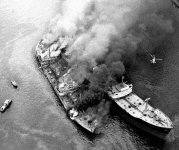
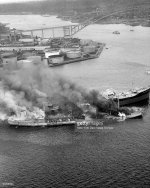
The two ships now drifted on their anchors and wound up side-by-side with Alva Cape in a position which exposed the gaping hole in her bow to the prevailing wind which fanned the flames that were rapidly consuming the both the fore and aft superstructures of the ship and leaving the crew still aboard with few places to hide awaiting rescue. Aboard the Texaco Massachusetts, the shift of the Alva Cape and the flames spewing from her had forced the majority of her crew who had initially taken shelter on the Stern to jump for their lives into Newark Bay, but also spared those still aboard by leaving the forward superstructure relatively smoke and fire-free.
The first official reports of the collision of the Alva Cape and Texaco Massachusetts reached the FDNY Marine Division shortly before 1:30pm local time from the department switchboard on Staten Island, where a call was relayed from a commercial tugboat Captain. After conferring with the US Coast Guard and the Bayonne Fire Department, the decision was made to dispatch FDNY units to the scene despite it being in New Jersey waters due to the risk of a major detonation causing tremendous damage to the surrounding area, particularly immediately adjacent tanks of the Texaco Bayonne terminal. Dispatched to the scene were the crews of Marine 1 aboard the John D. McKean, Marine 8 aboard the Alfred E. Smith, Marine 2 aboard the John J. Harvey and the Tender Smoke II. The crews aboard the Fire Fighter at Marine 9 were quick to report they were making ready to respond, despite the vessel being covered in scaffolding at the shipyard being repainted at the time of the incident.
First onscene was the Marine 1, whose crews were greeted by the sight of heavy fire stem to stern on the Alva Cape and an enormous and fiercely burning hole in her cargo tank, along with dozens of bodies in the water. With Coast Guard helicopters and small boats arriving and taking command of the rescue and recovery effort, the command of the firefighting effort went to the crew of Marine 1, who moved to and upwind position of the fire and prepared to attack the heavily involved Stern superstructure of the Alva Cape. Joined moments later by the Alfred E. Smith and reports that a helicopter had sighted trapped crew on the bridge wing of the Texaco Massachusetts, the firefighting effort was redirected to providing as much protection to the trapped men as possible as small craft and the helicopter moved in to attempt a rescue.
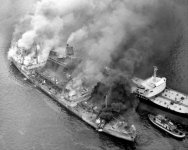
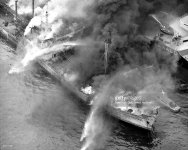
The Smith and Smoke II in the thick of it while attempting to rescue those trapped on the bridge wing of the Texaco Massachusetts
With the Coast Guard helo unable to get near the trapped men, the pilot of the Smith wasted no time in wedging his vessel between the two tankers as firefighters topside directed their monitors onto the furiously burning Alva Cape, with Smoke II directly behind them. Assisted moments later by the arrival of Marine 9 and Fire Fighter, the Smoke II backed out and allowed the Fighter to nose in directly behind the Smith and use her two forward fogging monitors to envelop the area in cocoon of spray, enabling a pair of fire fighters from the Smith to board the Texaco Massachusetts and begin removing the trapped mariners. With the last visible survivor pulled off both tankers, both the Fighter and Smith withdrew from their perilous location as a pair of commercial tugs took up the anchor line on the Texaco Massachusetts and began to tow her clear of the Alva Cape. As the two ships once again separated, responders were horrified to find the severely damaged and fire-ravaged hulls of both the Latin American and Esso Vermont lying alongside the Alva Cape, with no sign of survivors aboard and none likely to be found.
While the Smith and the recently arrived John J. Harvey of Marine 2 set about extinguishing the fires on the two tugs and the Texaco Massachusetts as they were each towed clear, Fire Fighter and McKean directed their efforts to combating the flames still threatening the remaining cargo aboard the Alva Cape. With Smoke II now running a regular supply of foam canisters and additional members from shoreside units, the two fireboats systematically knocked down the flames from her forward superstructure and foredeck, permitting firemen to board the ship and begin flooding the remaining cargo tanks with high-expansion foam to reduce the chance of further cargo catching fire or exploding. Thanks to strident efforts by the John J. Harvey, Coast Guard Cutters and commercial Tugs, the fires aboard the Texaco Massachusetts and the Latin American were declared extinguished at 3:25PM, allowing both ships to be towed out of the area. Fires aboard the Esso Vermont proved considerably more stubborn to combat, forcing the tug to be beached on Shooters Island after it began to list dangerously and threaten to sink in the navigation channel. With the ship no longer posing a potential navigation hazard, crews aboard the Harvey had her fires out by 4:55pm and transferred the wreck to the US Coast Guard recovery crews. Now free to focus their efforts on the Alva Cape, the combined efforts of Fire Fighter, Alfred E. Smith and John D. McKean and their crews had the numerous out-of-control fires aboard the Alva Cape under control by 6pm and extinguished at 6:40pm.
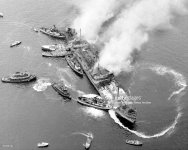
Marine Units 1 and 9 were released from the scene shortly after dark as recovery crews went aboard to locate any survivors and missing crew aboard the ship. What they found was a similarly grisly scene to what was found aboard the burned-out wrecks of the tugs Latin American and Esso Vermont, and by day’s end the count of lives lost was over 20 and climbing. Of the men from all four vessels who jumped from their ships into the waters of Newark Bay, only those with life jackets survived – a number which favored the crew of the Texaco Massachusetts far more than those aboard Alva Cape. By the time the badly damaged ship had been searched and the remaining cargo in her leaking #1 hold pumped off by salvage crews, the full and terrible toll of the days events had come into focus – 32 mariners had died in the fire; 19 from the Alva Cape, 3 from the Texaco Massachusetts, 4 from the Latin American and the entire 8-man crew of the Esso Vermont. A further 13 crew and over a dozen responders were injured, making the events of June 16th, 1966 the worst maritime disaster in New York Harbor since the loss of the General Slocum 62 years prior.
Unfortunately the Alva Cape would still sow more death and destruction before her time in New York was through. Still partially laden with Naphtha, the ship was towed to the designated explosives anchorage in Gravesend Bay on June 20th where salvage efforts were undertaken by the Merritt, Chapman and Scott Corporation under the watch of FDNY personnel aboard the Alfred E. Smith, which was alongside the ship. After four days of successful offloading, salvage crews working to remove the last ~30,000 barrels of Naphtha remaining aboard failed to inert the tank before starting their pumps on the afternoon of June 28th, causing the vapors in the ship’s #2 tank to explode in a tremendous blast and fire that ripped through the fore section of the ship and claimed the lives of four salvage crew. Three subsequent explosions followed, one of which badly damaged the Smith’s superstructure and forced her to cease firefighting operations on the vessel. Once again burning out of control, the ship was attended to by Fire Fighter, several Coast Guard Cutters and commercial tugs, the Alva Cape burned for several hours before the flames were brought under control at 4:30pm local time, allowing firemen to board and begin reapplying Hi-Ex foam to her tanks and extinguishing the fire by sundown.
After the second major incident aboard the ship, the Captain of the Port of New York had clearly had enough of the Alva Cape, and on July 1st the ship was ordered towed to sea and scuttled to prevent any further loss of life or damage to the harbor. Taken under tow by the tug Terry Moran on the morning of June 2nd, the Alva Cape was towed some 110 miles offshore to waters 1,200 fathoms deep and was set adrift in the vicinity of the US Coast Guard Cutter Spencer (WPG-36), which sent over 50 rounds into the derelict tanker and sank her at position 38°55′ N., 72°20.1’W on July 3rd, 1966.
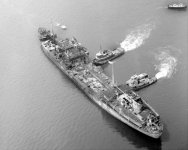
The hulk of the Alva Cape under salvage in Gravesend Bay, with the Smith alongside her superstructure.

SS Texaco Massachusetts

MV Alva Cape
Destined for the Bayway refinery and fully loaded with 132,854 barrels Light Virgin Naphtha, the Alva Cape was under the command of a Docking Pilot and being escorted by the tugboats Esso Massachusetts and Esso Vermont, the ship was nearing the Bayonne Bridge when her pilots hailed the outbound Texaco Massachusetts by radio to confirm their passing arrangements. Despite their discussion and agreement that the Texaco Massachusetts had the right of way in the upcoming routine passing situation, the two pilots improperly gauged the speed of each others vessels and in a matter of minutes the two ships were drawing dangerously close to each other. Recognizing the imminent danger, the pilot aboard the Texaco Massachusetts ordered the ships engines to full Astern in an attempt to bring the ship to a halt from its 3 knot speed while aboard the Alva Cape the pilot ordered the ships engine stopped and ordered the tug Esso Massachusetts to push her bow to Starboard in an effort to comb the approaching ship. These efforts were for naught. With a collision was imminent, Alva Cape’s engines were ordered to full Astern and her Starboard anchor dropped shortly before the bow of the high-riding Texaco Massachusetts cut into the Alva Cape on her Starboard hull near the front of her #1 cargo tank and penetrated a full 12ft into the ship before coming to a stop.
Despite immediately ordering the ships cargo smothering system energized to prevent an explosion from his ships highly flammable load, the Captain of the Alva Cape was unable to stop the engines of the Texaco Massachusetts, which were still running in full reverse, from pulling the vessel away from and removing the "plug" formed by the bow in the cargo tank. As the two ships separated with a tremendous jolt, a large amount of liquid Naphtha roiled forth from the Alva Cape and into the waters between the two ships and quickly began to gasify. The unfortunate crew of the tug Latin American were seen being overcome by the thick fumes covering their vessel and once the tugs engine began ingesting the gas, it began racing to ever-higher RPMs until it exploded and consumed the tug in a sheet of flames. Fire quickly spread to the water and air surrounding both tankers, setting the Alva Cape afire and causing a heavy Naphtha fume detonation that swept the forward decks of both ships with flames and shrapnel that either killed or badly burned every man stationed there. The flames quickly found their way to the tug Esso Vermont as well, and it too was completely engulfed in fire both inside and out in a matter of seconds.


The two ships now drifted on their anchors and wound up side-by-side with Alva Cape in a position which exposed the gaping hole in her bow to the prevailing wind which fanned the flames that were rapidly consuming the both the fore and aft superstructures of the ship and leaving the crew still aboard with few places to hide awaiting rescue. Aboard the Texaco Massachusetts, the shift of the Alva Cape and the flames spewing from her had forced the majority of her crew who had initially taken shelter on the Stern to jump for their lives into Newark Bay, but also spared those still aboard by leaving the forward superstructure relatively smoke and fire-free.
The first official reports of the collision of the Alva Cape and Texaco Massachusetts reached the FDNY Marine Division shortly before 1:30pm local time from the department switchboard on Staten Island, where a call was relayed from a commercial tugboat Captain. After conferring with the US Coast Guard and the Bayonne Fire Department, the decision was made to dispatch FDNY units to the scene despite it being in New Jersey waters due to the risk of a major detonation causing tremendous damage to the surrounding area, particularly immediately adjacent tanks of the Texaco Bayonne terminal. Dispatched to the scene were the crews of Marine 1 aboard the John D. McKean, Marine 8 aboard the Alfred E. Smith, Marine 2 aboard the John J. Harvey and the Tender Smoke II. The crews aboard the Fire Fighter at Marine 9 were quick to report they were making ready to respond, despite the vessel being covered in scaffolding at the shipyard being repainted at the time of the incident.
First onscene was the Marine 1, whose crews were greeted by the sight of heavy fire stem to stern on the Alva Cape and an enormous and fiercely burning hole in her cargo tank, along with dozens of bodies in the water. With Coast Guard helicopters and small boats arriving and taking command of the rescue and recovery effort, the command of the firefighting effort went to the crew of Marine 1, who moved to and upwind position of the fire and prepared to attack the heavily involved Stern superstructure of the Alva Cape. Joined moments later by the Alfred E. Smith and reports that a helicopter had sighted trapped crew on the bridge wing of the Texaco Massachusetts, the firefighting effort was redirected to providing as much protection to the trapped men as possible as small craft and the helicopter moved in to attempt a rescue.


The Smith and Smoke II in the thick of it while attempting to rescue those trapped on the bridge wing of the Texaco Massachusetts
With the Coast Guard helo unable to get near the trapped men, the pilot of the Smith wasted no time in wedging his vessel between the two tankers as firefighters topside directed their monitors onto the furiously burning Alva Cape, with Smoke II directly behind them. Assisted moments later by the arrival of Marine 9 and Fire Fighter, the Smoke II backed out and allowed the Fighter to nose in directly behind the Smith and use her two forward fogging monitors to envelop the area in cocoon of spray, enabling a pair of fire fighters from the Smith to board the Texaco Massachusetts and begin removing the trapped mariners. With the last visible survivor pulled off both tankers, both the Fighter and Smith withdrew from their perilous location as a pair of commercial tugs took up the anchor line on the Texaco Massachusetts and began to tow her clear of the Alva Cape. As the two ships once again separated, responders were horrified to find the severely damaged and fire-ravaged hulls of both the Latin American and Esso Vermont lying alongside the Alva Cape, with no sign of survivors aboard and none likely to be found.
While the Smith and the recently arrived John J. Harvey of Marine 2 set about extinguishing the fires on the two tugs and the Texaco Massachusetts as they were each towed clear, Fire Fighter and McKean directed their efforts to combating the flames still threatening the remaining cargo aboard the Alva Cape. With Smoke II now running a regular supply of foam canisters and additional members from shoreside units, the two fireboats systematically knocked down the flames from her forward superstructure and foredeck, permitting firemen to board the ship and begin flooding the remaining cargo tanks with high-expansion foam to reduce the chance of further cargo catching fire or exploding. Thanks to strident efforts by the John J. Harvey, Coast Guard Cutters and commercial Tugs, the fires aboard the Texaco Massachusetts and the Latin American were declared extinguished at 3:25PM, allowing both ships to be towed out of the area. Fires aboard the Esso Vermont proved considerably more stubborn to combat, forcing the tug to be beached on Shooters Island after it began to list dangerously and threaten to sink in the navigation channel. With the ship no longer posing a potential navigation hazard, crews aboard the Harvey had her fires out by 4:55pm and transferred the wreck to the US Coast Guard recovery crews. Now free to focus their efforts on the Alva Cape, the combined efforts of Fire Fighter, Alfred E. Smith and John D. McKean and their crews had the numerous out-of-control fires aboard the Alva Cape under control by 6pm and extinguished at 6:40pm.

Marine Units 1 and 9 were released from the scene shortly after dark as recovery crews went aboard to locate any survivors and missing crew aboard the ship. What they found was a similarly grisly scene to what was found aboard the burned-out wrecks of the tugs Latin American and Esso Vermont, and by day’s end the count of lives lost was over 20 and climbing. Of the men from all four vessels who jumped from their ships into the waters of Newark Bay, only those with life jackets survived – a number which favored the crew of the Texaco Massachusetts far more than those aboard Alva Cape. By the time the badly damaged ship had been searched and the remaining cargo in her leaking #1 hold pumped off by salvage crews, the full and terrible toll of the days events had come into focus – 32 mariners had died in the fire; 19 from the Alva Cape, 3 from the Texaco Massachusetts, 4 from the Latin American and the entire 8-man crew of the Esso Vermont. A further 13 crew and over a dozen responders were injured, making the events of June 16th, 1966 the worst maritime disaster in New York Harbor since the loss of the General Slocum 62 years prior.
Unfortunately the Alva Cape would still sow more death and destruction before her time in New York was through. Still partially laden with Naphtha, the ship was towed to the designated explosives anchorage in Gravesend Bay on June 20th where salvage efforts were undertaken by the Merritt, Chapman and Scott Corporation under the watch of FDNY personnel aboard the Alfred E. Smith, which was alongside the ship. After four days of successful offloading, salvage crews working to remove the last ~30,000 barrels of Naphtha remaining aboard failed to inert the tank before starting their pumps on the afternoon of June 28th, causing the vapors in the ship’s #2 tank to explode in a tremendous blast and fire that ripped through the fore section of the ship and claimed the lives of four salvage crew. Three subsequent explosions followed, one of which badly damaged the Smith’s superstructure and forced her to cease firefighting operations on the vessel. Once again burning out of control, the ship was attended to by Fire Fighter, several Coast Guard Cutters and commercial tugs, the Alva Cape burned for several hours before the flames were brought under control at 4:30pm local time, allowing firemen to board and begin reapplying Hi-Ex foam to her tanks and extinguishing the fire by sundown.
After the second major incident aboard the ship, the Captain of the Port of New York had clearly had enough of the Alva Cape, and on July 1st the ship was ordered towed to sea and scuttled to prevent any further loss of life or damage to the harbor. Taken under tow by the tug Terry Moran on the morning of June 2nd, the Alva Cape was towed some 110 miles offshore to waters 1,200 fathoms deep and was set adrift in the vicinity of the US Coast Guard Cutter Spencer (WPG-36), which sent over 50 rounds into the derelict tanker and sank her at position 38°55′ N., 72°20.1’W on July 3rd, 1966.

The hulk of the Alva Cape under salvage in Gravesend Bay, with the Smith alongside her superstructure.
Last edited:

